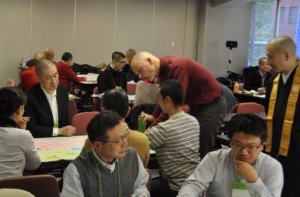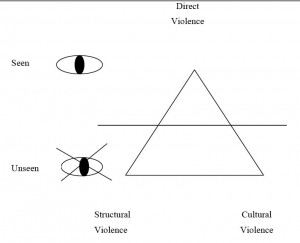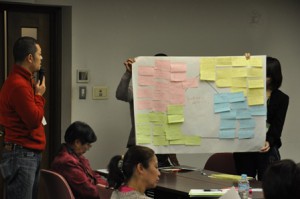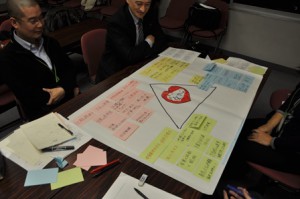Level II: Workshop #5 December 4, 2013
Buddhist Social Analysis
Jonathan Watts
Introduction
Buddhist chaplains and engaged Buddhists learn from and use knowledge and skills from many different fields. This fits with a wider understanding of Buddhism as not confined to religious concepts but as an investigation of the world and its many dharmas as well as using accumulated wisdom in skillful ways (upaya) to relieve suffering. On the other hand, a chaplain's role is not to be an expert in medicine, environmental science, political strategy or any field in which they engage. A chaplain's special skill is to bring a Buddhist perspective to their field of endeavor and to society in general. This requires a particularly skilled synthesis of understanding various fields of social endeavor yet learning how to think like a Buddhist-not like a Marxist or a scientist or an economist, etc.
The basis of such Buddhist "thinking" is rooted in the praxis of the Buddha's core injunctions called the Four Noble Truths. Often understood on a simplistic or literal level as statements of fact about the nature of existence, some Buddhists have been able to penetrate the inner meaning of them as injunctions to experiential practice. In recent decades, many socially engaged Buddhists have used the Four Noble Truths to understand the nature and causes of social problems (dukkha) and plan a course to action to solve them (nirodha). Working in the International Network of Engaged Buddhists (INEB) for over 20 years, I and my colleagues have developed experiential workshops using the Four Noble Truths to address issues such as end of life care, gender equality, non-violent activism, and youth training. As a component of the Rinsho Buddhism Chaplaincy Training program, we used this Four Noble Truths format to conduct a half day workshop with the chaplains-in-training in order to give them a tool for not only reflecting on and analyzing the complex social issues in their work but also working with groups of suffering persons to develop solidarity and community in facing these issues.
1st Noble Truth: Confronting the Experience of Dukkha
To begin the workshop, we needed to explain these deeper layers of the Four Noble Truths and how to use them to analyze society and develop action. A conventional presentation of the Four Noble Truths can go as follows:
1) Life and existence are dukkha; that is, full of suffering, the inability to develop lasting satisfaction, and a feeling of perpetual dis-ease or lack.
2) The cause of dukkha occurs through an interdependent causal process?not by the will of a creator God?which begins with ignorance, develops through craving and attachment, and culminates in the birth of a dissatisfied "self".
3) Nirvana is the cessation of this causal chain of dukkha.
4) There is a way to accomplish this cessation of dukkha, specifically through the Buddha's Eightfold Path of training in ethics (sila), inner cultivation (samadhi), and understanding the nature of existence (panna).
To then approach these four as an analytical framework, we consider the First Noble Truth as a question: What is the problem? In other words, what is the issue we are centrally contending with and how does it express itself? In this exercise, we are not yet ready to speak about systems or beliefs like, "The problem is the eduation system" or "The problem is men's attitudes towards women." While these are important to consider, it is more important as a first step to speak about what is directly experienced. The reason is that there can be a tendency, especially among assertively educated types of people, to start from analytical concepts and abstractions; rather than shared experiences. We re-affirm the "truth" of this first injunction by speaking the truth of the experience of dukkha, which often times is not recognized when it is the suffering of persons or sentient life marginalized from power.
 In
the workshop, we broke the participants into groups of 4 people based on common
fields of interest for their chaplaincy, such as suicide, disaster trauma,
youth problems, etc. Each participant was then given 3 large post-it papers
and asked to write down 3 of the most critical forms of dukkha in their field
as a concrete and observable experience; for example, PTSD, domestic violence,
homelessness. The participants were then asked to share their these three
forms of direct dukkha with the other members of their group, making sure
that each person had equal time to discuss their post-its.
In
the workshop, we broke the participants into groups of 4 people based on common
fields of interest for their chaplaincy, such as suicide, disaster trauma,
youth problems, etc. Each participant was then given 3 large post-it papers
and asked to write down 3 of the most critical forms of dukkha in their field
as a concrete and observable experience; for example, PTSD, domestic violence,
homelessness. The participants were then asked to share their these three
forms of direct dukkha with the other members of their group, making sure
that each person had equal time to discuss their post-its.
2nd Noble Truth: Exposing the Hidden Causes of Dukkha
From this experiential standpoint, we then presented the participants with a more analytical framework as the Second Noble truth, which seeks to identify the causes of the dukkha. The Second Noble Truth is traditionally explained in detail as the 12 fold causal chain of Dependent Co-Origination (pattica sumuppada) that begins with ignorance and develops through craving and attachment into the birth of a suffering "self". In order to make this complex model more workable and usable on a social level, my colleagues and I in INEB have used the seminal concepts of structural violence and cultural violence developed by Norwegian peace systems thinker Johan Galtung, who has often expressed a great affinity for Buddhist thought. In this way, we introduced to the participants both of these concepts as follows:
・Structural Violence are the systems, institutions, and methods which lead to harm to our basic human needs of survival, well-being, identity, freedom, and nature.
・Cultural Violence are the values, symbols, ideas, and beliefs (found in religion and ideology, language and art, and science) used to justify, or legitimize direct or structural violence.
From a Buddhist standpoint, we might call these structural dukkha and cultural dukkha, which means that confronting them involves not only taking social action but also transforming one's own unconscious patterns of belief, thought, and action in our daily lives that support these roots of dukkha. To better understand this triad of concepts?direct, structural, and cultural dukkha-that comprise the First and Second Noble Truths, we have developed the following chart:
The Iceberg of Dukkha
 With direct violence as the directly observable and experience of dukkha at
the apex of the iceberg poking out of the water, structural and cultural violence
then form its base, usually hidden from sight as "the way things work"
or "the way people think".
With direct violence as the directly observable and experience of dukkha at
the apex of the iceberg poking out of the water, structural and cultural violence
then form its base, usually hidden from sight as "the way things work"
or "the way people think".
After explaining this matrix to the participants, each group drew a triangular "iceberg" on a large sheet of paper and attached their post-its for direct dukkha at the top, while taking time to discuss and organize them according to common themes. The participants were then asked to individually identify 3 causes for each of the 3 sufferings (a total 9 for each person) and write them down in brief phrases on post-its. Then as a group, they discussed them and tried to identify whether each one was structural or cultural, or even somewhat in between, while posting them on the lower part of iceberg. At the conclusion of this work, a representative from each group then presented their iceberg of the First and Second Noble Truths to the entire gathering.
"Comrades in Dukkha": Building Solidarity through a Community of Sharing
 As
a summary to this first half of the workshop, I explained how we might understand
this process from a more experiential standpoint; that is, either in working
with our own problems or in helping a group of sufferers become more aware
of their problems. Thus the question of the First Noble Truth, "What
is the problem"?, becomes, "How do I/we experience the problem?"
The Four Noble Truths as an injunction to practice means that we begin firmly
with the experience of dukkha, something that we usually do our best to turn
away from through various forms of entertainment, dispersion, and intoxication.
Obviously, such temporary solutions do not solve the problem and may eventually
develop into larger problems (e.g. alcoholism). Yet the confrontation with
suffering is an intense and difficult one, and we find the need to share it
and to tell our stories with friends, family, or some kind of safe community.
This community of sharing (dana) is the real meaning of sangha in Buddhism,
not just the typical understanding of it as the community of monks. As such,
sharing and story telling are essential in any group setting for creating
an atmosphere of right speech and deep listening, a core competency of the
Buddhist chaplain. These practices help to empower all members to participate
actively and equally before the more intellectual work of social analysis
is done in the Second Noble Truth.
As
a summary to this first half of the workshop, I explained how we might understand
this process from a more experiential standpoint; that is, either in working
with our own problems or in helping a group of sufferers become more aware
of their problems. Thus the question of the First Noble Truth, "What
is the problem"?, becomes, "How do I/we experience the problem?"
The Four Noble Truths as an injunction to practice means that we begin firmly
with the experience of dukkha, something that we usually do our best to turn
away from through various forms of entertainment, dispersion, and intoxication.
Obviously, such temporary solutions do not solve the problem and may eventually
develop into larger problems (e.g. alcoholism). Yet the confrontation with
suffering is an intense and difficult one, and we find the need to share it
and to tell our stories with friends, family, or some kind of safe community.
This community of sharing (dana) is the real meaning of sangha in Buddhism,
not just the typical understanding of it as the community of monks. As such,
sharing and story telling are essential in any group setting for creating
an atmosphere of right speech and deep listening, a core competency of the
Buddhist chaplain. These practices help to empower all members to participate
actively and equally before the more intellectual work of social analysis
is done in the Second Noble Truth.
The Second Noble Truth in turn morphs into the more experiential injunction, "How do we discover the causes, conditions, and processes that create the dukkha?" By sharing our own suffering with others in a community (sangha) of sharing (dana), an important therapeutic experience can occur, such as: We see that we are not alone and that others suffer from similar problems. We see that our suffering is not completely our own fault. Seeing that our and others' suffering is due to causes and conditions, which involve others and society, and that these shared connections are shared dukkha, leads us to see the Buddha's proposition of the insubstantial nature of a separate self (anatman); i.e. "This is not my suffering alone." The group or community (sangha) of sharing also offers a place to explore more deeply the causes and conditions of personal and social suffering and to examine structural and cultural causes, building further solidarity for engaging in the Third and Four Noble Truths.
3rd Noble Truth: Emerging into Enlightened Vision
Firmly establishing ourselves in the experience of dukkha and then working to uncover its hidden causes on a personal, interpersonal, and social level, we are guided into the discovery of the 3rd Noble Truth. The eminent Thai forest master Buddhadasa Bhikkhu spoke of the 3rd Noble Truth as the purpose of dukkha. This suffering has led us on an experiential journey to discover its ending and the state off nirvana. The purpose of the dukkha is thus as a stepping stone to enlightenment. As other great spiritual traditions have concurred, suffering is never without meaning for it can always bring us closer to the holy or spiritual. It beckons us to make contact with a higher "self" that deconcocts the causes of dukkha through a more enlightened way of living. In this way, my colleagues and I have framed the 3rd Noble Truth as the development of vision; that is, developing a vision for a society and a way of living that is free of dukkha.
 For this group process, we asked the participants to draw up a new 3 point
"iceberg of nirvana" and write down three post-its describing in
brief the experiential aspects of a healthy community in terms of their specific
issue or region. This part of the workshop is particularly open and free,
and sometimes participants have difficulty in the more creative work of envisioning.
However, vision is an essential process in that it forms the foundation for
subsequent action and keeps us rooted when the complexities of engagement
confuse or distract us. In this way, the process can be opened further, and
participants can be allowed to further chart their vision through imagining
values as the enlightened counterpart of cultural dukkha as well as new institutions
and systems as the enlightened counterpart of structural dukkha. As participants
become more familiar with this method of the Four Noble Truths, they can work
more freely within the "iceberg of nirvana", which is by nature
transparent and not broken into seen and unseen parts.
For this group process, we asked the participants to draw up a new 3 point
"iceberg of nirvana" and write down three post-its describing in
brief the experiential aspects of a healthy community in terms of their specific
issue or region. This part of the workshop is particularly open and free,
and sometimes participants have difficulty in the more creative work of envisioning.
However, vision is an essential process in that it forms the foundation for
subsequent action and keeps us rooted when the complexities of engagement
confuse or distract us. In this way, the process can be opened further, and
participants can be allowed to further chart their vision through imagining
values as the enlightened counterpart of cultural dukkha as well as new institutions
and systems as the enlightened counterpart of structural dukkha. As participants
become more familiar with this method of the Four Noble Truths, they can work
more freely within the "iceberg of nirvana", which is by nature
transparent and not broken into seen and unseen parts.
4th Noble Truth: Strategic Work to End Dukkha and Realize Nirvana
In this way, the 4th Noble Truth begins to emerge from the process of envisioning nirvana, which is not a nebulous state of transcendental consciousness but the "cooling" or "blowing out" of the burning flames of individual angst, interpersonal conflict, and social injustice. After engaging in envisioning work, participants can also be led through a more strategic approach to the 3rd and 4th Noble Truths. Joanna Macy, a seminal Buddhist thinker and social activist, has developed a similar three point model for Buddhist social action as: holding actions to stop further dukkha, analysis of structural causes and the creation of structural alternatives, and a shift in consciousness.link Holding Actions as various strategic activities to address direct dukkha, especially various kinds of emergency support and aid, are a step participants can envisions and plan as the top point in their "iceberg of nirvana"; i.e. direct action to end direct dukkha. Developing from this process, participants can then identify 3-5 structural or cultural activities that strike at the structural and cultural causes of dukkha they discovered in the first half of the workshop.
A further extension of this activity is to choose one of the "opponents" who upholds these systems and cultures of dukkha and explore ways in which they could be transformed from: 1) antagonists to neutral forces and then 2) neutral forces to allies. This exercise tries instill a sense of non-duality with opposing forces and then to turn opposition in resource. Participants can also choose one ally and try to see how they can enlist them to develop further concrete strategies
Conclusion
For this particular workshop, as we were limited to only three hours, we led the participants through the basic envisioning process as the 3rd Noble Truth and identifying 3-5 structural or cultural activities as the 4th Noble Truth. A key point in the workshop is continuing to use the post-its as a way to emphasize the full participation of all the participants and make sure each voice is heard and recorded (on the post-its).
As a summary, I again explained to the participants how this workshop method can be used in their chaplaincy to work with groups of suffering people to develop further solidarity and action. In review, as individuals begin to confront their dukkha in a community of sharing, they can see that they are not alone, that others like them suffer, and that we are all connected in suffering together. This leads to a genuine experience of compassion (karuna), "to feel with" and to experience another's suffering as one's own. The experience of connection and compassion with others is the first taste of nirvana. From this basis within a group or community, members can engage in the envisioning and strategic planning and action as outlined above. Their vision and strategy can of course be augmented by the "vision and strategy" of the Buddha found in his Noble Eightfold Path of practice as an expression of the 4th Noble Truth. One of our INEB colleagues and a main disciple of Buddhadasa Bikkhu, Santikaro developed an understanding of the Buddha's Noble Eightfold Path on a social level as the Noble Twelvefold Social Path that envisions:
1) Right Understanding as Right Religion and Right Education
2) Right Thought as Right Leadership and Right Organization & Government
3) Right Speech as Right Communication
4) Right Action as Right Culture and Right Family & Sexuality
5) Right Livelihood as Right Economy and Right Ecology
6) Right Effort as Right Play
7) Right Mindfulness as Right Monitoring
8) Right Concentration as Right Sangha & Solidarity

